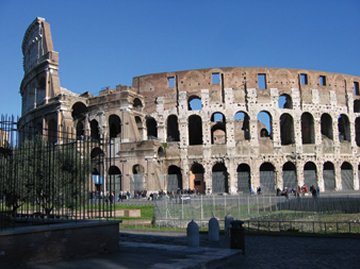If a large earthquake struck Rome, ground motions could rock the city for up to a minute, a new simulation suggests. Strong shaking for that surprisingly long interval would threaten many of the city’s aging landmarks.

Earthquakes that shake Rome and gradually degrade its ancient structures typically originate in one of two places: the Alban Hills region, about 25 kilometers southeast of the city, or the Central Apennines, a mountain range about 90 km to the east. At least 20 large quakes have shaken the city in the past 2,000 years. The most recent, estimated at magnitude 7.0, occurred in 1915, says Kim B. Olsen, a geophysicist at San Diego State University. However, none of the region’s seismic instruments had yet been installed, so detailed analyses of ground motions generated by major quakes in the area haven’t been possible.
Rome covers the floodplain of the Tiber River. Because the sediments supporting the city haven’t yet solidified into rock, strong and sustained ground motions can cause the soil to shift, settle, and even liquefy and flow, says Olsen. Data gathered from more than 1,000 boreholes drilled in and around the city indicate that the soil and silt beneath the city is about 50 meters thick. Below that lies a thin layer of gravel over bedrock.
Olsen and his colleagues used the borehole data to construct a first-of-its-kind, three-dimensional computer model of the geology of Rome and its environs. Then, they subjected the model to simulations of two earthquakes typical of past large quakes in the region—a magnitude 5.3 quake centered in the Alban Hills and a magnitude 7.0 temblor originating in the Central Apennines.
The greatest ground motions caused by the simulated quakes appeared along the edges of the floodplain, where seismic waves traveling through the sediment bounced off the rocky edges of the river valley and reinforced each other.
Olsen notes that parts of central Rome that experienced large ground motions during the simulations were locations that had been heavily damaged in actual quakes.
What surprised team members was that the virtual quake originating in the Central Apennines shook Rome for as long as a minute, he notes. Seismic vibrations in the sediments under the city echoed back and forth through the basin, extending the quake’s duration. The researchers report their results in the February Bulletin of the Seismological Society of America.
Simulations such as these could enable scientists to determine which of Rome’s ancient buildings are most at risk of collapse during a major quake, says Kirk Martini, a structural engineer at the University of Virginia in Charlottesville. Preservationists could then focus their costly and time-consuming efforts on seismically retrofitting the most vulnerable historical sites.






